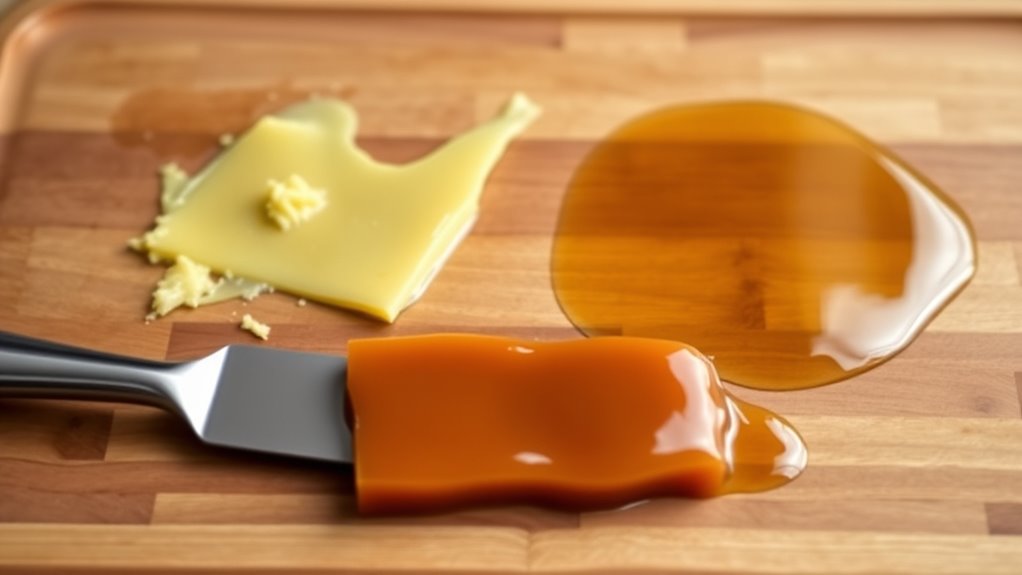When it comes to cutting sticky foods, butter’s rich texture helps the knife glide smoothly and reduces sticking. It coats the blade nicely, making cuts cleaner. On the other hand, oil provides a lighter consistency that prevents sticky doughs from adhering to surfaces, especially in pasta or pizza. Both options have their advantages, depending on what you’re making and your flavor preferences. Stick around, and you’ll discover even more insights into the best choice for your needs.
Key Takeaways
- Butter’s creamy texture helps knives glide smoothly through sticky mixtures, reducing sticking during cutting.
- A small amount of butter coats the knife, enhancing cutting efficiency for dense doughs.
- Oil’s lighter consistency prevents high-moisture doughs from adhering to surfaces and blades.
- Both butter and oil improve cutting ease, but butter offers a more substantial surface coating.
- Combining butter and oil can balance flavor complexity and cutting functionality effectively.

When you’re tackling sticky foods, choosing the right lubricant can make all the difference. Whether you’re cutting through a batch of dough or slicing a particularly gooey dessert, the right choice between butter and oil can impact both your experience and the final result. Let’s plunge into how each option plays a role in dough preparation and flavor enhancement, helping you become more efficient in the kitchen.
Butter is often the go-to choice for many bakers. Its rich, creamy texture not only provides a great surface for cutting but also contributes a depth of flavor that oil simply can’t match. When you’re preparing dough, a little butter can coat your knife, allowing it to glide smoothly through sticky mixtures like cookie or cake batter. Plus, the flavor enhancement from butter adds a delicious dimension to your baked goods. You’ll notice how the buttery notes transform a simple recipe into something extraordinary, elevating your culinary creations.
Butter’s rich texture and flavor elevate baked goods, allowing for smooth cutting through sticky mixtures and transforming simple recipes into extraordinary creations.
On the other hand, oil offers its own set of advantages. It’s lighter than butter, which can be beneficial when you’re dealing with particularly sticky foods. A drizzle of oil on your cutting surface or knife can help prevent dough from sticking, especially when you’re working with dough that’s high in moisture. This can be especially useful in certain dough preparations, like pasta or pizza, where you want a clean cut without the heaviness that butter might impart. Plus, oil is incredibly versatile; you can choose different types for varied flavor profiles, such as olive oil for a Mediterranean twist or coconut oil for a hint of sweetness.
When it comes to flavor enhancement, you’ll find that butter takes the cake—literally. Its ability to enrich the taste of baked goods is unmatched. However, using oil doesn’t mean you have to sacrifice taste. You can easily experiment with infused oils or combine oil and butter to achieve the perfect balance. This way, you can enjoy both the smooth cutting experience that oil provides and the flavor depth that butter brings.
Ultimately, the choice between butter and oil for cutting sticky foods depends on your specific needs and preferences. By understanding the benefits of each, you can make an informed decision that enhances both your dough preparation and the flavors of your dishes. Interestingly, butter has a long history of cultural significance in culinary traditions, which further adds to its appeal in the kitchen. Whether you opt for the classic richness of butter or the versatility of oil, you’re sure to improve your kitchen game.
Frequently Asked Questions
Can I Use Margarine Instead of Butter for Cutting Sticky Foods?
Yes, you can use margarine instead of butter for cutting sticky foods. Margarine serves as a suitable replacement, especially if you’re looking for vegan alternatives. It helps create a non-stick surface, making it easier to slice through items like cheese or sticky dough. Just guarantee the margarine you choose has a similar consistency to butter for the best results. Enjoy your cooking and make clean cuts effortlessly!
Is There a Vegan Alternative to Butter or Oil for Cutting?
Yes, you can use vegan butter or plant-based oils as alternatives for cutting. Vegan butter works well because it has a similar consistency to regular butter, helping to prevent sticking. On the other hand, plant-based oils like coconut or avocado oil are great options too; just apply a light layer to your cutting surface. These choices will keep your sticky foods from adhering, making your prep work smoother and easier.
How Do I Clean My Knife After Cutting Sticky Foods?
After cutting sticky foods, you can clean your knife effectively by using warm, soapy water. Soak the knife briefly to loosen any residue, then scrub gently with a non-abrasive sponge. Rinse thoroughly and dry it immediately to prevent rust. For knife maintenance, consider using a mixture of vinegar and baking soda for tougher residues. This cleaning technique not only keeps your knife in top shape but also guarantees it stays sharp and functional.
Does Temperature Affect Butter or Oil’s Effectiveness in Cutting?
Absolutely, temperature affects both butter and oil’s effectiveness in cutting. When it’s warm, fats melt, creating a slick surface that helps glide through sticky foods. If you’re using cold butter, it can become more solid and less effective, making it stickier. Think of it like a dance—when the temperature’s right, the moves are smooth and effortless. So, keep your fats at the right temperature to achieve that perfect cut!
Are There Specific Oils Better Suited for Cutting Sticky Foods?
Yes, certain oils are better suited for cutting sticky foods. When you use cooking oil or vegetable oil, they create a non-stick surface that helps your knife glide through. Oils like canola or sunflower work well because they have a neutral flavor and a high smoke point, making them versatile for various sticky items. Just coat your knife lightly with oil, and you’ll find cutting much smoother and easier!
Conclusion
When you’re slicing through sticky foods, remember that butter’s creamy embrace can sometimes hold you back, while oil glides like a well-oiled machine. Each has its strengths, but for a clean cut, oil often steals the show, letting your knife dance effortlessly through the mess. So, next time you’re faced with a sticky situation, reach for the oil—your knife will thank you, and your dish will shine like a polished gem. Happy cutting!










